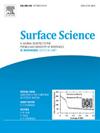Ag(110)表面的碘吸附:单轴压缩和碘化物生长
IF 2.1
4区 化学
Q3 CHEMISTRY, PHYSICAL
引用次数: 0
摘要
利用室温扫描隧道显微镜(STM)和低能电子衍射(LEED)结合密度泛函理论(DFT)计算,研究了超高真空条件下Ag(110)对碘的吸附。发现在低覆盖率下,碘形成c(2×2)结构。碘的进一步吸附导致沿[lt;110>]槽中的原子被压缩。分离c(2×2)畴的方向和畴壁的形成。随着覆盖范围的增加,槽内的压缩导致畴壁消失,碘原子形成扭曲的六边形结构。这种结构被表面上更多的碘所压缩。随着碘的进一步暴露,AgI岛在单层碘上形成。岛屿的形成始于原子台阶的边缘,发现岛屿的顶层也具有扭曲的六边形结构。在这个结构中,原子行有一个方向与“x”相一致。基底的方向。原子排的另外两个方向相对于基底转动,在岛屿表面形成云纹图案。AgI以双层蜂窝状(DLHC)三明治状结构生长。本文章由计算机程序翻译,如有差异,请以英文原文为准。
Iodine adsorption on the Ag(110) surface: Uniaxial compression and iodide growth
Adsorption of iodine on Ag(110) has been studied in ultra high vacuum with room temperature scanning tunneling microscopy (STM) and low energy electron diffraction (LEED) in combination with density functional theory (DFT) calculations. It was found that at low coverages iodine forms structure. Further adsorption of iodine leads to compression of atoms in the troughs along direction and formation of domain walls separating domains. As the coverage increases compression in the troughs causes domain walls to disappear and iodine atoms to form a distorted hexagonal structure. This structure is compressed with more iodine on the surface. With further exposure to iodine AgI islands are formed on the monolayer of iodine. The formation of islands begins at the edges of atomic steps and it was found that the top layers of islands also have distorted hexagonal structure. In this structure one of the directions of atomic rows coincide with the direction of the substrate. The other two directions of atomic rows are turned relatively to substrate causing a moire pattern on the surface of islands. The AgI growth occurs in the form of double layer honeycomb (DLHC) sandwich-like structure.
求助全文
通过发布文献求助,成功后即可免费获取论文全文。
去求助
来源期刊

Surface Science
化学-物理:凝聚态物理
CiteScore
3.30
自引率
5.30%
发文量
137
审稿时长
25 days
期刊介绍:
Surface Science is devoted to elucidating the fundamental aspects of chemistry and physics occurring at a wide range of surfaces and interfaces and to disseminating this knowledge fast. The journal welcomes a broad spectrum of topics, including but not limited to:
• model systems (e.g. in Ultra High Vacuum) under well-controlled reactive conditions
• nanoscale science and engineering, including manipulation of matter at the atomic/molecular scale and assembly phenomena
• reactivity of surfaces as related to various applied areas including heterogeneous catalysis, chemistry at electrified interfaces, and semiconductors functionalization
• phenomena at interfaces relevant to energy storage and conversion, and fuels production and utilization
• surface reactivity for environmental protection and pollution remediation
• interactions at surfaces of soft matter, including polymers and biomaterials.
Both experimental and theoretical work, including modeling, is within the scope of the journal. Work published in Surface Science reaches a wide readership, from chemistry and physics to biology and materials science and engineering, providing an excellent forum for cross-fertilization of ideas and broad dissemination of scientific discoveries.
 求助内容:
求助内容: 应助结果提醒方式:
应助结果提醒方式:


